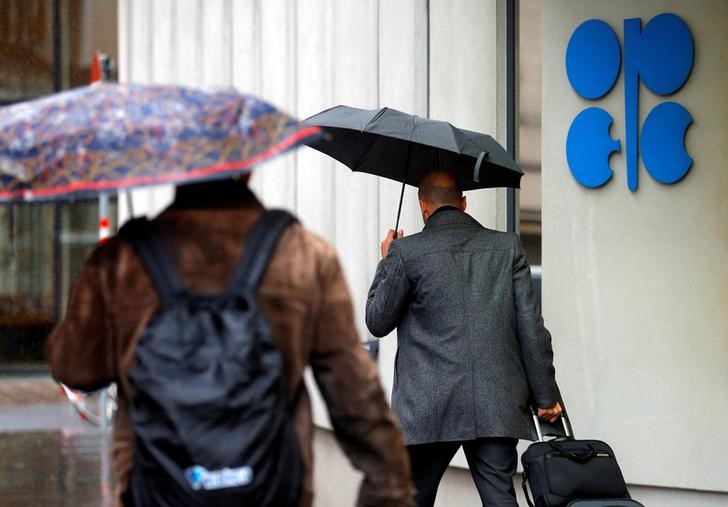EUR/USD likely to find a peak near 1.25: UBS
* OPEC+ reaches deal to slash output by 9.7 mln bpd -
sources
* Cuts equal to about 10% of global supply
* U.S. output seen dropping by 2 mln bpd due to low prices
* Worldwide fuel consumption down 30% from coronavirus
effects
* Citi, Morgan Stanley raise Brent price forecasts in H2
(Updates prices)
By Florence Tan
SINGAPORE, April 13 (Reuters) - Oil prices rose on Monday
after major producers finally agreed their biggest-ever output
cut, but gains were capped amid concern that it won't be enough
to head off oversupply with the coronavirus pandemic hammering
demand.
After four days of wrangling, the Organization of the
Petroleum Exporting Countries (OPEC), Russia and other
producers, a group known as OPEC+, agreed on Sunday to cut
output by 9.7 million barrels per day (bpd) in May and June to
support oil prices, representing around 10% of global supply.
Brent crude LCOc1 futures rose 16 cents, or 0.5%, to
$31.64 a barrel by 0709 GMT after opening at a session high of
$33.99. U.S. West Texas Intermediate (WTI) crude CLc1 futures
were up 37 cents, or 1.6%, to $23.13 a barrel, after hitting a
high of $24.74.
"What this deal does is enable the global oil industry and
the national economies and other industries that depend upon it
to avoid a very deep crisis," said IHS Markit Vice Chairman
Daniel Yergin.
"This restrains the build-up of inventories, which will
reduce the pressure on prices when normality returns – whenever
that is."
Leaders of the world's top three oil producers, Russian
President Vladimir Putin, U.S. President Donald Trump and Saudi
Arabia's King Salman, all supported the OPEC+ deal to cut global
crude output, the Kremlin said on Sunday. Trump praised the deal, saying it would save jobs in the
U.S. energy industry. Saudi Arabia, Kuwait and the United Arab Emirates
volunteered to make cuts even deeper than those agreed, which
would effectively bring the OPEC+ supply down by 12.5 million
bpd from current supply levels, the Saudi energy minister said.
However, analysts cast doubts on producers' likely
compliance with the cuts, adding that the actual reductions may
not be as high as the volume pledged by producers. Furthermore, demand concerns capped oil price gains.
Worldwide fuel consumption is down roughly 30%, due to the
COVID-19 pandemic caused by the novel coronavirus that has
killed more than 100,000 people worldwide and kept businesses
and governments on lockdown. "After an initial positive reaction in oil prices, we expect
the OPEC+ decision at best to establish a floor under the
market," BNP Paribas' Harry Tchilinguirian said in a note,
adding that oil price gains could also be capped by hedges from
producers.
"We do not expect a sustained recovery in the oil price
until pent-up demand is released in Q3," he said.
The deal had been delayed since Thursday after Mexico balked
at the production cuts it was asked to make. The OPEC+ group met
on Sunday to hammer out the agreement, resulting in an output
cut four times deeper than the previous record reduction in
2008.
OPEC+ has also said it wanted producers outside the group,
such as the United States, Canada, Brazil and Norway, to cut a
further 5% or 5 million bpd.
Canada and Norway signalled a willingness to cut. The United
States, where antitrust legislation makes it hard to act in
tandem with groups such as OPEC, has said its output would
already fall by as much as 2 million bpd this year without
planned cuts because of low prices.
"We're going to see a significant drop in production anyway
from producers who can't make money producing," said Phil Flynn,
an analyst at Price Futures group.
However, optimism over the longer term impact of the OPEC+
cuts have lifted prices for future months, widening Brent's
contango, the market structure when later dated prices are
higher than prompt supplies. LCOc1-LCOc7
"By (the third quarter), these cuts should make a difference
and result in induced inventory draws for most of the rest of
2020," Citi analysts said as the bank raised its Brent price
forecasts for third and fourth quarter to $35 and $45 a barrel,
respectively.
Morgan Stanley has also raised its forecasts by $5 for the
second half of the year to $30 to $35 a barrel.
<^^^^^^^^^^^^^^^^^^^^^^^^^^^^^^^^^^^^^^^^^^^^^^^^^^^^^^^^^^^
Brent crude forward curve https://reut.rs/2K2Gctn
^^^^^^^^^^^^^^^^^^^^^^^^^^^^^^^^^^^^^^^^^^^^^^^^^^^^^^^^^^^>
